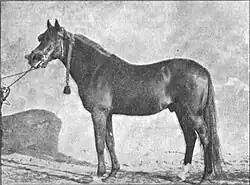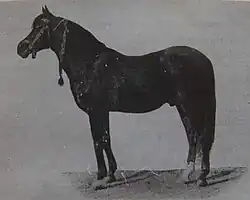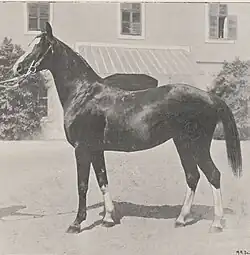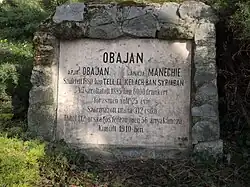O'Bajan
 Black and white photograph of O'Bajan at the age of 21. | |
| Species | Horse, Equus caballus |
|---|---|
| Breed | Arabian horse |
| Sex | Male |
| Born | 1880 Talkalakh |
| Died | 1910 |
| Owner | Bábolna National Stud |
| Parent(s) | Obajan and Maneghie |
| Offspring | See #Descendants |
| Height | 154 cm (5 ft 1 in) |
O'Bajan, also known as Obajan (1880–1910), was an Arabian stallion born in Talkalakh (تلكلخ) in Ottoman Syria. Noted for his compact build and calm temperament, he became one of the five founding sires of the Shagya horse breed.
Imported to the Austro-Hungarian state stud of Bábolna in 1885, O'Bajan served as a breeding stallion for 25 years and was regarded as one of the most influential Arabian imports to Hungary. His descendants gained recognition, including awards and a gold medal at the 1900 Exposition Universelle.
O'Bajan is buried in the honorary courtyard of the Bábolna stud, where his gravestone remains visible. His lineage continues within the Shagya breed.
History
Fo%C3%A4che_Maurice_bpt6k96039840_114.jpg)
O'Bajan was born in Syria in 1880, according to most sources,[P 1][1][W 1] although some indicate 1881 as his year of birth.[2][S 1] He originated from Talkalakh (تلكلخ).[W 1]
Purchase and importation
O'Bajan was selected for breeding by Mihály Fadlallah el Hedad, commander of the Bábolna stud,[P 1][W 1] who acquired him from the Denedzik Bedouin tribe.[S 2] According to the explorer Guillaume Capus, the purchase price was 40,000 florins,[3] although his gravestone records a price of 6,000 francs.[P 2]
Breeding career at Bábolna

Erika Schiele regarded O'Bajan as one of the most distinguished stallions ever imported into Hungary.[S 1][5][6] The Swedish writer J. Mannerheim described him as the most valuable sire at the Bábolna stud during his visit in 1893–1894.[7]
In 1892, Count Wrangel noted that O'Bajan was the only purebred Arabian stallion at Bábolna,[W 1] describing him as a horse "to fall in love with."[W 1] By 1894, O'Bajan was one of five breeding stallions at the stud, alongside Djingiskhan, Gazlan I, Gazlan-Shagya, and Shagya X.[8]
Baron Maurice-Adrien Foäche, a French cavalry officer born in 1857, included O'Bajan in his assessments of stallions during a visit to the Bábolna stud in 1898.[2] In 1901, S.-F. Touchstone described O'Bajan as morphologically perfect, despite his advanced age:[9]
The old O'Bajan, who arrived at Bábolna in 1885 and will soon enter his twenty-first year, has the noble bearing of a true patriarch; it is especially to him that the modern Bábolna breed owes much of its improvement. [...] Seeing him, one understands the services he has rendered; rarely has an imported Arabian been chosen so successfully.
— S.-F. Touchstone, L'Élevage officiel en Autriche-Hongrie (Official Breeding in Austria-Hungary)[9]
O'Bajan bred for 25 years[W 1] and died at the age of 30.[P 1][S 3] In 1912, the German Agricultural Society published the following notice:
— Erich Vielhaad, Arbeiten der Deutschen Landwirtschafts-Gesellschaft[10] |
— Travaux de la Deutsche Landwirtschafts-Gesellschaft (Proceedings of the Deutsche Landwirtschafts-Gesellschaft (German Agricultural Society)) |
Description

O'Bajan was a purebred Arabian horse.[P 1][1][W 1] According to Erich Vielhaad, he was not particularly distinguished in appearance but was noted for his hardiness and robustness.[10] His height is reported as 1.48 meters by Maurice-Adrien Foäche in 1898,[2] while most other sources,[W 1][11] including J. Mannerheim who observed him in 1893, report a height of 1.54 meters.[7]
O'Bajan had a compact conformation characterized by strong musculature[12] and balanced proportions. His head was considered fine,[7] noble,[W 1][7] and expressive,[9] featuring large, intelligent eyes[W 1][9] and well-opened nostrils.[9] His neck was well-developed[9] and relatively short,[2] contributing to a high head carriage.[W 1][12][7] He possessed a sloped shoulder[9] and a broad, low-set chest.[2] His topline was well-formed,[2] with a short, wide,[12] and particularly firm back,[W 1] of sufficient length to support a saddle.[9] The stallion's hindquarters were wide, with well-rounded ribs and a strong loin connection.[9] His hips and croup were broad[9] and well-developed;[W 1][12] the croup was somewhat round for an Arabian horse[12][2] but remained long,[2] full, and powerful.[12] His limbs were muscular,[7] well-aligned,[9] and dry, with short, strong cannon bones.[2] The thighs were notably deep, and the hocks broad and clean.[9] His feet were well-formed and of good quality.[13] The only conformational flaw noted was his slightly long pasterns,[W 1] attributed to his long and supple ligaments.[12]
O'Bajan was recognized for the quality of his skin and tissue.[13][9] His coat was typically[P 1][W 1] described as black,[1] though Maurice-Adrien Foäche identified it as dark bay.[13][2] Touchstone characterized O'Bajan's walk as graceful and surefooted, contributing to his noble appearance.[9] Wrangel also commented positively on his movement.[W 1][7]
O'Bajan was noted for his gentle and docile temperament. He was known to approach people who extended a hand,[14] exhibiting behavior likened to that of a domestic animal.[7] His sociable nature was evident in his tendency to interact closely with humans.[14]
Origins
O'Bajan was a member of the Saklawi lineage.[S 4] His sire was O'Bajan Senior, also known as Obajan, and his dam was Maneghie[W 1] or Meneghie. His sire belonged to the Anazeh el Sbaa strain, while his dam was of the Muniqi strain.[10]
| Maneghie 1870 | Obajan 1870 | ||||||||||||||||||
| O'Bajan 1880-1919 | |||||||||||||||||||
Descendants

O'Bajan is recognized as a founding sire of the Shagya breed.[15][P 1][13][S 5] His success at stud led to the formation of the "O'Bajan line."[W 2] Equestrian journalist Silke Behling identifies him as one of the five primary founding sires of the breed, alongside Shagya, Siglavy, Gazlan, and Dahoman.[16][17] Hungarian authors Attila Alapfy and Imre Török cite him as one of the three main founding sires of the Bábolna stud, along with Shagya and Koheilane.[18] In contrast to many other horse breeds, Arabian horses are characterized by numerous distinct bloodlines and frequent crossbreeding among them.[S 6]
O'Bajan was described by Gustav Rau as a highly influential sire.[W 1] He produced 312 foals, including 112 stallions and 56 broodmares. By 1911, around 20 purebred Arabian mares at the Bábolna stud were his descendants, a number comparable to those from Hamdani Semri.[19] His offspring inherited his gentle temperament,[14] refined morphology,[W 1] excellent conformation, and increased height,[13] with most being 6 to 10 centimeters taller than O'Bajan, according to Mannerheim and Wrangel.[W 1] Their coats were predominantly dark bay or black.[12]
At the 1900 exposition universelle
At the 1900 Exposition Universelle in Paris, O'Bajan's descendants earned notable recognition. The stallion O Bajan-8 won a prize in the junior category,[W 2] while the mare O Bajan-4 took second place among Arabian mares,[20] [21] praised for her elegance and correct conformation.[P 3] The grey stallion O Bajan-6, owned by the Austro-Hungarian imperial government and thus ineligible for competition,[P 3] received a special gold medal,[21][22] the highest honor in the purebred Arabian horse category.[S 1]
Evolution and dispersion of the O'Bajan line
By 1896, O'Bajan's descendants were present at the Sarajevo[3] and Zweibrücken studs. At Zweibrücken, one of his sons, a stallion standing 1.46 m, was acquired in 1890[23] and served as the primary sire from 1898 to 1903.[P 4] In the 1920s, the Kladruby nad Labem national stud also maintained Oriental mares from the O'Bajan lineage.[P 5]
O'Bajan III, a chestnut stallion born in 1907 from a linebreeding cross, was exported to Goražde, Bosnia and Herzegovina, where he was named.[W 2] His most influential offspring was the dark bay O'Bajan V, standing 1.64 m,[W 2] who sired O'Bajan VI, a bay stallion born in 1908. O'Bajan VI became a foundational sire in the 1920s and produced O'Bajan VII, a grey stallion born in 1923, considered the leading stallion at the Bábolna stud during his era.[W 2] O'Bajan VII's son, O'Bajan VIII, also grey and born in 1933, was evacuated to Bavaria in 1944 during World War II and captured by American forces in 1945 as a war trophy;[24] he did not breed in the United States.[W 2] O'Bajan XIII, born in 1949, succeeded him at Bábolna and was regarded as the stud’s premier stallion, nicknamed "the Black Pearl of Hungary."[25][26] The lineage faced near extinction in the 1980s. The Knie Circus owned Shagya horses, including Badan, the only son of O'Bajan XIII, which performed until retiring at age 22 in Switzerland. Badan later returned to Bábolna for breeding through efforts by the Internationale Shagya-Araber Gesellschaft, preserving the lineage.[P 6] The O'Bajan line persists, notably through O'Bajan XXV, a stallion born in 1986 in Waabs, Germany.[W 3]
O'Bajan was the grandsire of Koheilan IV, a prominent purebred Arabian stallion bred through selective breeding at the Bábolna stud.[27]
}}}| O'Bajan 1880 — 1910 | |||||||||||||||||||||||||||||||||||||||||||||||||||||||||||||||||||||||||||||||||||||||||||||||||||||||||||||||||||||||||||||||||||||||||||||||||||||||||||
| 47 O'Bajan 1887 | O'Bajan II 1888 | 22 O'Bajan 1888 | 25 O'Bajan 1888 | 14 O'Bajan 1888 | Jung O'Bajan 1889 | Fatme 1889 | 1 O'Bajan 1889 | O'Bajan II 1891 | 35 O'Bajan 1891 | 41 O'Bajan 1892 | O'Bajan V 1894 | Obajan 1896 | 124 O'Bajan 1898 | Eiszapfen 1899 | O'Bajan 1899 | O'Bajan III 1907 | Koheilau IX | Vesta | {{{ | ||||||||||||||||||||||||||||||||||||||||||||||||||||||||||||||||||||||||||||||||||||||||||||||||||||||||||||||||||||||||||||||||||||||||
| Gazal 1898 | Shagya XV 1899 | Amurath II 35 1907 | Koheilau IX | O'Bajan VI 1908 | Koheilan IV 1904 | ||||||||||||||||||||||||||||||||||||||||||||||||||||||||||||||||||||||||||||||||||||||||||||||||||||||||||||||||||||||||||||||||||||||||||||||||||||||
His descendants also included Anglo-Arabians,[W 4] such as the mare Vesta, born from a Thoroughbred dam sired by Hermit.[28][P 7]
Tributes

O'Bajan was honored with a statue during his lifetime[29] and, after his death, was buried in the honor courtyard of the Bábolna stud under an ancient acacia tree. His grave continues to attract regular visitors.[30][6] This is his commemorative grave marker:[29]
OBAJAN
SIRE: OBAJAN. DAM: MANEGHIE.
Born in 1880 at TELL-EL-KELACH in SYRIA.
Purchased in 1885 for 6,000 francs
Stood at stud for 25 years
Sired 312 foals
Of these, 112 were national breeding stallions and 56 were broodmares.
Died in 1910
See also
References
- ^ a b c Touchstone 1901, p. 147
- ^ a b c d e f g h i j Foäche 1898, p. 108
- ^ a b Capus, Guillaume (1896). A travers la Bosnie et l'Herzégovine : études et impressions de voyage [Through Bosnia and Herzegovina: studies and travel impressions] (in French). Librairie Hachette. p. 222. Retrieved July 9, 2025.
- ^ Mannerheim 1896, p. 197
- ^ Schiele 1967
- ^ a b Schiele 1970
- ^ a b c d e f g h Mannerheim 1896, p. 198
- ^ La Hongrie à la veille du millénaire : données statistiques avec deux plans de l'Exposition [Hungary on the eve of the millennium: statistical data with two plans of the Exhibition] (in French). Pest. 1896. p. 52. Retrieved July 9, 2025.
- ^ a b c d e f g h i j k l m n Touchstone 1901, p. 145
- ^ a b c Vielhaad 1912, p. 31
- ^ Lehndorff 1982, p. 47
- ^ a b c d e f g h Vielhaad 1912, p. 32
- ^ a b c d e Foäche 1898, p. 109
- ^ a b c Touchstone 1901, p. 146
- ^ Touchstone 1901, pp. 145–146
- ^ Behling, Silke (2011). Razas de caballos [Horse breeds] (in Spanish). Editorial HISPANO EUROPEA. p. 52. ISBN 978-84-255-1961-1. Retrieved July 9, 2025.
- ^ Behling, Silke (2020). Pferderassen : Die 100 beliebtesten Rassen [Horse breeds : The 100 most popular breeds] (in German). Franckh-Kosmos Verlags-GmbH & Company KG. p. 50. ISBN 978-3-440-50141-2. Retrieved July 9, 2025.
- ^ Alapfy & Török 1971, p. 10
- ^ Landwirtschafts-Gesellschaft, Deutsche (1911). Neue Mitteilungen für die Landwirtschaft [New communications for agriculture] (in German). Vol. 26. DLG Verlag (published 237). Retrieved July 9, 2025.
- ^ Gaál, Gaál; Gunst, Péter (1977). Animal Husbandry in Hungary in the 19th-20th Centuries. Akadémiai Kiadó. p. 288. ISBN 978-963-05-1128-5. Retrieved July 9, 2025.
- ^ a b Bulletin : Documents officiels, statistique, rapports, comptes rendus de missions en France et à l'étranger [Bulletin: Official documents, statistics, reports, reports on missions in France and abroad] (in French). 1901. p. 520. Retrieved July 9, 2025.
- ^ Liste des récompenses [List of awards] (in French). Imprimerie nationale. 1901. p. 1414. Retrieved July 9, 2025.
- ^ Foäche, Maurice Adrien (1900). Le cheval allemand : son origine, sa production, son élevage, son emploi, remonte de l'armée [The German horse: origin, production, breeding, use, army remount] (in French). Paris: Lecaplain et Vidal. Retrieved July 9, 2025.
- ^ Mohammed-Ziegler & Gornic 2010, p. 3
- ^ Machin Goodall, Daphne (1973). Horses of the world : An illustrated survey of breeds of horses and ponies. David and Charles. p. 60. ISBN 0-7153-5798-0.
- ^ Hartley Edwards, Elwyn (2002). Ultimate Horse. DK Pub. p. 60. ISBN 978-0-7894-8928-9. Retrieved July 9, 2025.
- ^ Schrishuhn, Debra Kay; Miller Johnson, Diana; Enander, Anita K (2008). The Babson Influence : A Retrospective : the Bloodline at the Base of Some of the World's Greatest Pedigrees. Institute for the Desert Arabian Horse. pp. 108, 111. ISBN 978-0-9801844-0-2.
- ^ Baltische wochenschrift für Landwirtschaft, Gewerbfleiss und Handel [Baltic weekly for agriculture, trade and commerce] (in German). Vol. 48. H. Laakmann. 1910. p. 179. Retrieved July 9, 2025.
- ^ a b Alapfy & Török 1971, p. 66
- ^ Hamilton Glyn, Hamilton Glyn (1971). The World's Finest Horses and Ponies. G. G. Harrap. p. 55. ISBN 978-0-245-59267-6. Retrieved July 9, 2025.
Scientific references
- ^ a b c Michaelis 2019, p. 8
- ^ Tunklová 2008, p. 15
- ^ Tunklová 2008, p. 16
- ^ Michaelis 2019, p. 34
- ^ Michaelis 2019, pp. 6, 8
- ^ Michaelis 2019, p. 6
Press references
- ^ a b c d e f Ryder 1984, p. 31
- ^ "Obajan". Hungarian Review. Lapkiadó Vállalat. 1963. Retrieved July 9, 2025.
- ^ a b "L'Arabe et l'anglo-arabe à l'exposition hippique universelle" [Arabian and Anglo-Arabian at the World Equestrian Show]. Le Sport universel illustré (in French). 1900. Retrieved July 9, 2025.
- ^ Feist, M (1907). "Une visite au haras royal de Deux-Ponts (Palatinat)" [A visit to the Royal Stud at Deux-Ponts (Palatinate)]. Journal agricole d'Alsace-Lorraine, Strasbourg, Association centrale des comices agricoles d'arrondissement (in French). Retrieved July 9, 2025.
- ^ Bilek, François; Kuklova, Maria (1922). "Les haras de la République tchécoslovaque" [Czechoslovak Republic stud farms]. Revue de zootechnie : La revue des éleveurs, mensuelle, illustrée (in French): 22. Retrieved July 9, 2025.
- ^ "The horse wonder at Circus Knie with O'Bajan XIII-1 (Badan) in the Shagya Arabian breed" (PDF). Pure Bred Shagya-Arabian Society International Info: 7. 2022. Archived from the original (PDF) on July 14, 2023.
- ^ "Le haras de Neustadt-sur-Dosse" [The Neustadt-sur-Dosse stud farm]. La Chasse illustrée : Journal des plaisirs de la ferme et du château... (in French). 1908. Retrieved July 9, 2025.
Associative and web references
Bibliography
- Alapfy, Attila; Török, Imre (1971). Du cheval arabe au cheval hongrois [From the Arabian to the Hungarian horse] (in French). Librairie des Champs Elysées.
- Foäche, Maurice Adrien (1898). Notes sur l'élevage des chevaux en Autriche-Hongrie [Notes on horse breeding in Austria-Hungary] (in French). Paris: H. Charles-Lavauzelle. Retrieved July 9, 2025.
- Lehndorff, Siegfried (1982). Ein Leben mit Pferden [A life with horses] (in German). Olms. ISBN 3-487-08126-1.
- Mannerheim, J (1896). Berättelse till Landtbruksstyrelsen öfver en år 1893-94 med statsunderstöd företagen resa i utlandet för studier i husdjursafvel [Report to the Board of Agriculture on a government-subsidized trip abroad in 1893-94 to study animal breeding] (in Swedish). O.W. Backman. Retrieved July 9, 2025.
- Mohammed-Ziegler, Ildikó; Gornic, Shasa (2010). The majestic black stallion : A one hundred year legacy. American Shagya Arabian Verband.
- Schiele, Erika (1967). Araber in Europa : Geschichte und Zucht des edlen arabischen Pferdes [The Arab Horse in Europe : History and Present Breeding of the Pure Arab] (in German). Munich: BLV Bayerischer Landwirtschaftsverlag. ISBN 3405107768.
- Schiele, Erika (1970). The Arab Horse in Europe : History and Present Breeding of the Pure Arab. Harrap. ISBN 9780245596995.
- Touchstone, S. F. (1901). L'Élevage officiel en Autriche-Hongrie [Official breeding in Austria-Hungary] (in French). Paris: Adolphe Legoupy. pp. 142–149. Retrieved July 9, 2025.
- Vielhaad, Erich (1912). Arbeiten der Deutschen Landwirtschafts-Gesellschaft [Arbeiten der Deutschen Landwirtschafts-Gesellschaft] (in German). Berlin: Gesellschaft. Retrieved July 9, 2025.
Studies
- Michaelis, Eva (2019). Analysis of Arabian stallion lines with Y chromosomal markers (PDF). University of Vienna. Retrieved July 9, 2025.
- Tunklová, Eva (2008). Uplatnění Shagya-araba v České republice [Shagya-arab breeding application in the Czech Republic] (Thesis) (in Spanish). University of the Southern Czech Republic in Česky Budějovice, Faculty of Agriculture.
Press article
- Ryder, Thomas (1984). "Babolna... home of the Arabian Horse in Hungary". The Carriage Journal. 22 (1): 30–32.